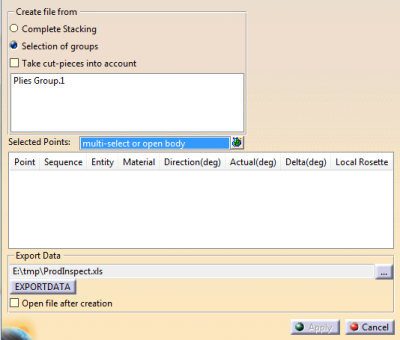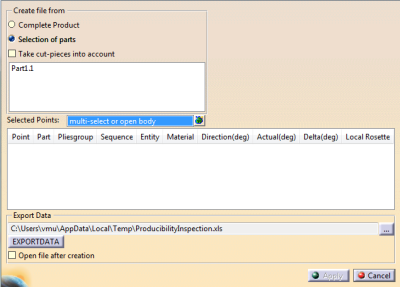in order to detect manufacturability problems.
Available in DMU Composites Review (CPR), in a CATProduct context, if a Composites Design (CPD), Composites Engineering Design (CPE) and Composites Design for Manufacturing (CPM) is available.
- Part_01.CATPart from the samples\Composites directory if you are working in CPD, CPE or CPM.
- CPD_01.CATProduct from the samples\Composites directory if you are working in CPR.
-
Click Producibility Inspection
 in the Flattening or Analysis toolbar.
in the Flattening or Analysis toolbar.
The Inspection Analysis dialog box is displayed.
In Composites Design (CPD) and Composites Engineering Design (CPE):

In DMU Composites Review (CPR):

-
Select the entity on which you want to perform the analysis:
In Composites Design (CPD) and Composites Engineering Design (CPE): - Complete Stacking
- Selection of groups.
In DMU Composites Review (CPR):
- Complete product
- Selection of parts.
-
If necessary, select the Take cut-pieces into account check box.
-
Select the inspection points.
- Either select an open body containing the inspection points.
- Or click Multi-selection
 to select the points
individually.
to select the points
individually.
They are displayed in the Inspection Points dialog box that opens.
Close that dialog box to revert to the Inspection Analysis dialog box.

A core sample analysis is made for each point, so make sure they are inside the ply,
otherwise the analysis cannot be performed. -
Click Apply.
The dialog box is updated:

The parameters for each ply are displayed, among which:-
Delta: angle of
deviation computed by the produciblity analysis, that is angle between
the transferred theoretical rosette and the actual fiber direction (along the X axis). - Actual: difference between the nominal direction of the ply and the delta.
See Using Non Crimp Fabrics in the Composites Design User's Guide for specific information. -
Delta: angle of
deviation computed by the produciblity analysis, that is angle between
-
If needed, export the inspection data.
- Click ... to select the storage path of the exported data file, and the format (.xls, .xlsx or .txt).
- Select Open file after creation.
- Click EXPORTDATA.
The exported file opens. It contains the same information as the one displayed in the dialog box.
![]()